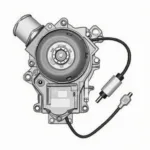Leather car seats exude luxury and comfort but are prone to wear and tear. Scratches, cracks, and fading are common issues faced by car owners. While professional repair is an option, understanding how to repair leather car seats yourself can save you money and preserve your car’s interior. This comprehensive guide will delve into DIY leather car seat repair, offering tips, tricks, and step-by-step instructions to bring your seats back to life.
Identifying the Damage: The First Step to Repair
Before diving into the repair process, it’s crucial to assess the type and severity of the damage.
- Cracks: These are often caused by age, heat, and dryness. Small, superficial cracks can often be addressed with DIY methods, while deeper cracks might require professional attention.
- Scratches: Ranging from minor scuffs to deep gouges, scratches usually result from sharp objects or pet claws.
- Fading and Discoloration: Exposure to sunlight can fade leather over time.
Essential Tools and Materials
Gathering the right tools and materials is essential for effective DIY leather car seat repair. Here’s a basic list:
- Leather Cleaner: Opt for a dedicated leather cleaner to remove dirt, grime, and oils without drying out the leather.
- Leather Conditioner: This helps replenish moisture and keep the leather supple, preventing future cracks.
- Leather Repair Kit: Available online or at auto stores, these kits typically contain filler compounds, colorants, and various applicators.
- Soft Cloths: Microfiber cloths work best for cleaning and applying products.
- Rubbing Alcohol: Used for cleaning the area before repair.
- Masking Tape: Useful for protecting surrounding areas during the repair process.
- Hair Dryer: Helps speed up the drying time of leather fillers and conditioners.
DIY Leather Car Seat Repair: Step-by-Step Guide
Now, let’s break down the repair process into manageable steps:
1. Thoroughly Clean the Area: Use a leather cleaner and a soft cloth to clean the damaged area and surrounding surfaces. This ensures the repair products adhere properly.
2. Assess and Prepare the Damage: For scratches and cracks, gently sand the area with fine-grit sandpaper to create a smooth surface for the filler to bond.
3. Apply Leather Filler (If Necessary): If the damage is more than superficial, apply a leather filler compound to fill in cracks or deep scratches. Follow the instructions provided with your chosen repair kit.
4. Color Matching and Application: Once the filler dries, use a colorant from your repair kit that closely matches your car’s leather. Apply thin coats, allowing each layer to dry before applying the next.
5. Blend and Smooth: After the colorant dries, use a soft cloth to gently blend the edges of the repaired area with the surrounding leather for a seamless look.
6. Apply Leather Conditioner: To finish, apply a high-quality leather conditioner to the entire seat. This helps protect the leather, restore its suppleness, and prevent future cracking.
Can you repair dog scratches on car leather seats? Yes, the above steps are effective for repairing minor to moderate dog scratches.
Maintaining Your Repaired Leather Car Seats
Maintaining your leather car seats after repair is crucial for long-lasting results:
- Regular Cleaning: Clean your leather seats every few weeks or as needed using a dedicated leather cleaner.
- Conditioning: Apply a leather conditioner every few months to keep the leather moisturized and prevent cracking.
- UV Protection: Park your car in the shade or use a sunshade to minimize UV damage and fading.
How much does it cost to repair leather car seats? The cost can vary widely depending on the severity of the damage and whether you choose DIY or professional repair. However, DIY repair using a kit is a significantly more affordable option.
 Conditioned leather car seat
Conditioned leather car seat
Conclusion
Repairing your leather car seats doesn’t have to be a daunting task. By following these steps and using the right products, you can restore their beauty and extend their lifespan. Remember, regular maintenance is key to keeping your leather seats looking their best for years to come. For specific issues like slits, burn holes, or extensive damage, consider seeking professional help or exploring more specialized guides.
FAQ
Q: How often should I condition my leather car seats?
A: It’s generally recommended to condition your leather car seats every 3-4 months, but this can vary depending on climate and usage.
Q: Can I use household cleaners on my leather seats?
A: It’s best to avoid using household cleaners, as they can contain harsh chemicals that can damage leather.
Q: How can I prevent my leather seats from cracking?
A: Regular cleaning, conditioning, and protecting your seats from UV damage are the best ways to prevent cracking.
Q: Can I dye my leather car seats a different color?
A: While possible, dyeing leather car seats is a more complex process and might require professional expertise.
Q: What should I do if the damage to my leather seats is severe?
A: For severe damage, such as large tears or extensive cracking, it’s best to consult a professional leather repair specialist.
Do you have other questions related to car seat repair? You can find more information on our blog. Here are a few articles that might interest you:
- How do you repair slits in leather car seat
- How do I repair cracked leather car seats
- How to repair burn holes in leather car seats
Need professional assistance with your car repair needs? Contact our team 24/7 via WhatsApp: +1(641)206-8880 or Email: [email protected]. We’re always here to help!


